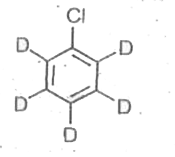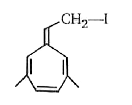In Dow's process haloarene is converted to phenol with fused NAOH . The most reactive compound is



All are equally reactive
The correct Answer is:A
To solve the question regarding the most reactive compound in Dow's process where haloarene is converted to phenol using fused NaOH, we can follow these steps:
1. Understand Dow's Process:
- Dow's process involves the conversion of haloarenes (aromatic compounds with halogen substituents) to phenols using molten sodium hydroxide (NaOH) at high temperatures (around 370°C).
- The reaction mechanism involves the formation of a benzyne intermediate.
2. Identify the Reaction Mechanism:
- In the presence of NaOH, the hydroxide ion (OH-) abstracts a hydrogen atom from the haloarene, resulting in the formation of a negatively charged intermediate.
- The halogen (e.g., Cl) is then eliminated, leading to the formation of the benzyne intermediate, which is highly reactive.
3. Consider the Types of Bonds:
- The reactivity of haloarenes in this process depends on the strength of the carbon-halogen bond (C-X bond) that needs to break.
- The types of bonds that can be present in the haloarene are C-H, C-D (deuterium), and C-T (tritium).
4. Compare Bond Strengths:
- The bond strengths are as follows:
- C-H bond (weakest)
- C-D bond (stronger than C-H)
- C-T bond (strongest)
- Since the C-H bond is the weakest, it will break more easily compared to C-D and C-T bonds.
5. Determine the Most Reactive Compound:
- The compound with the C-H bond will be the most reactive in the Dow's process because it will cleave faster, leading to the formation of the benzyne intermediate more readily.
- Therefore, the haloarene containing the C-H bond will react the quickest and thus be the most reactive.
6. Conclusion:
- Based on the analysis, the correct answer is the compound that contains the C-H bond, as it will undergo the reaction more rapidly than those containing C-D or C-T bonds.
Final Answer:
The most reactive compound in Dow's process is the one that contains the C-H bond.
---
- Dow's process involves the conversion of haloarenes (aromatic compounds with halogen substituents) to phenols using molten sodium hydroxide (NaOH) at high temperatures (around 370°C).
- The reaction mechanism involves the formation of a benzyne intermediate.
- In the presence of NaOH, the hydroxide ion (OH-) abstracts a hydrogen atom from the haloarene, resulting in the formation of a negatively charged intermediate.
- The halogen (e.g., Cl) is then eliminated, leading to the formation of the benzyne intermediate, which is highly reactive.
- The reactivity of haloarenes in this process depends on the strength of the carbon-halogen bond (C-X bond) that needs to break.
- The types of bonds that can be present in the haloarene are C-H, C-D (deuterium), and C-T (tritium).
- The bond strengths are as follows:
- C-H bond (weakest)
- C-D bond (stronger than C-H)
- C-T bond (strongest)
- Since the C-H bond is the weakest, it will break more easily compared to C-D and C-T bonds.
- The compound with the C-H bond will be the most reactive in the Dow's process because it will cleave faster, leading to the formation of the benzyne intermediate more readily.
- Therefore, the haloarene containing the C-H bond will react the quickest and thus be the most reactive.
- Based on the analysis, the correct answer is the compound that contains the C-H bond, as it will undergo the reaction more rapidly than those containing C-D or C-T bonds.
The most reactive compound in Dow's process is the one that contains the C-H bond.
Topper's Solved these Questions
- ALCOHOLS, PHENOLS AND ETHERSBOOK - AAKASH INSTITUTE ENGLISHCHAPTER - ALCOHOLS, PHENOLS AND ETHERSEXERCISE - Assignment Section - C (Previous Years questions)
25 Videos
- ALCOHOLS, PHENOLS AND ETHERSBOOK - AAKASH INSTITUTE ENGLISHCHAPTER - ALCOHOLS, PHENOLS AND ETHERSEXERCISE - Assignment Section - C (Questions asked Prior to medical Ent. Exams. 2005)
13 Videos
- ALCOHOLS, PHENOLS AND ETHERSBOOK - AAKASH INSTITUTE ENGLISHCHAPTER - ALCOHOLS, PHENOLS AND ETHERSEXERCISE - Assignment Section - A (Objective type questions)
45 Videos
- ALCOHOLS, PHENOLS AND ETHERS BOOK - AAKASH INSTITUTE ENGLISHCHAPTER - ALCOHOLS, PHENOLS AND ETHERS EXERCISE - Try Yourself
5 Videos
Similar Questions
Knowledge Check
Most reactive compound toward SN1 is :
A B
B C
C D
D
Which of the following is most reactive towards aqueous NaOH?
AC6H5ClBC6H5CH2ClCC6H5BrDBrC6H4Br
Sodium metal can be extracted by either Castner's Process or Down's process
Castner's process.
Electrolyte → fused NaOH
Cathode and anode are made up of a steel rod and Ni cylinder respectively the reaction takes place as follows :
At cathode Na++e−→Na
At anode OH−→12H2O+14O2↑⏐ ⏐⏐+e−
Down's process :
Electrolyte → fused NaCl and CaCl2
Cathode and anode are ring shaped iron metal and graphite respectively. The reaction takes place as follows :
Na++e−→Na
Cl−→12Cl2↑⏐ ⏐⏐+e−
CaCl2 is used along with NaCl due to
View SolutionThe compound that is most reactive with alcoholic KOH is
View SolutionThe process by which a polar covalent compound is converted into ions in aqueous solution
View SolutionA Colorless solid A liberates a brown gas B on acidification, a colorless alkaline gas (C)on treatment with NaOH and a colorless non-reactive gas D on heating. If heating of the solid is continued, it completely disappears.
The compound A is
View SolutionA compound has molecular formula C6H12O. It does not reduce Tollens or Fehling's reagent, but gives a crystalline derivative with 2,4-dinitro-phenyl hydrazine. With alkali and I2, it gives yellow solid with a medicinal odour. Clemmensen reduction converts it to 2-methylpentane. The structure formula of the compound is most likely to be:
View SolutionWhich of the following process is used based on the ability of metal being converted into volatile compound ?
View Solution
